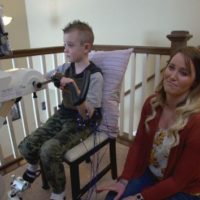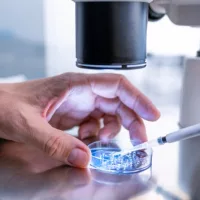
 Quinton Hill, who was diagnosed with acute flaccid myelitis, exercises his arms. (ABC News)By KRISTOFER RIOS, JASMINE BROWN and ANTHONY RIVAS, ABC News
Quinton Hill, who was diagnosed with acute flaccid myelitis, exercises his arms. (ABC News)By KRISTOFER RIOS, JASMINE BROWN and ANTHONY RIVAS, ABC News
(NEW YORK) — Quinton Hill was only 8 years old when he underwent a potentially life-changing surgery.
It was one that could not only affect his future but that of other children who one day might be diagnosed with the rare and mysterious “polio-like” illness acute flaccid myelitis (AFM).
In 2018, Quinton was one of at least 237 children in 41 states who were diagnosed with AFM, a debilitating disease that causes muscle weakness and paralysis and can sometimes lead to deadly complications, according to the Centers for Disease Control and Prevention (CDC). The disease carries almost no warning signs. It comes on quickly and mostly affects children.
Quinton was in church when his father said he began feeling symptoms of a cold.
“He started complaining that he just had a little bit of a sore throat … the beginning signs of a cold,” James Hill, Quinton’s father, said. “So we’re like, ‘We’ll go home early. We don’t want to make anyone else sick.'”
But Quinton’s condition worsened. After enduring a week of flu-like symptoms, his father said he became unable to move his left arm.
“We went into the hospital and even they were confused … they ran a ton of tests. He had two MRIs, initially. He had a spinal tap. He had X-rays,” said Hill.
After two weeks of testing, doctors told the Hill family that Quinton might have AFM.
“That’s the first time that we heard the term AFM,” Hill said. “I literally didn’t sleep that night. I Googled a lot of stuff and tried to figure out next steps and whatnot. And it was all unknown … no known cure. No known treatment. Don’t know how it spreads.”
Thousands of confused and scared parents were given the same news that year — that their kids were affected by the 2018 AFM outbreak. Minneapolis, where Quinton lived with his family, was the outbreak’s epicenter.
Camdyn was diagnosed at 4 years old with AFM at the Kennedy Krieger Institute in Baltimore. The disease had struck at a crucial point in his development, leaving him mostly paralyzed from the neck down — only able to move his right leg and left hand.
ABC News’ Nightline first met 4-year-old Camdyn in October 2018 while he was recovering at the Kennedy Krieger Institute, which specializes in treating AFM patients. At the time, therapists were working tirelessly to help Camdyn regain some mobility in his limbs.
Today, Camdyn is still paralyzed but improving. His father, Chris Carr, says the disease has affected his son in “every way, shape or form you can imagine.”
“He can’t use a bathroom on his own. Can’t scratch his own nose [or] arm. Can’t eat. … He’s got a [gastronomy] tube, his own trach tube,” Carr said.
Moreover, the disease has taken an immense mental toll on the young boy, his father said.
“The [post-traumatic stress disorder] is starting to eat away at that good, wholesome little child and starting to turn him into an angry old man at 5 years old,” Carr said. “It’s just awful to watch. It really is.”
Initially unable to afford a home nursing aide, Camdyn’s parents took full responsibility for his care after returning home from the hospital following his diagnosis. The Carr home is now filled with medical supplies and medication lists for Camdyn.
“The scary thing about coming home was knowing it was all on myself because I’m the only certified caregiver,” Carr said. “So I’m the only person that can do anything in an emergency situation for him. If I mess up and my son passes away, it’s on my shoulders. No one else’s.”
Carr said that most of the time, he’s fearful something will happen to Camdyn.
“You’re always on edge,” he said. “You always feel like something is going to happen at any given time. That’s why I don’t sleep.”
A CDC task force was created in 2014 after an outbreak of the disease to research and track the rare condition. Since then, it has found that the disease seems to emerge in greater numbers every two years during the fall, and that each outbreak is worse than the last. This year, health experts are sounding the alarm that another AFM outbreak could coincide with the COVID-19 pandemic.
Since the CDC began looking into the disease, it has discovered that viral infections — like the flu — are common in many patients who are diagnosed with AFM. In fact, over 90% of patients diagnosed with AFM also had mild respiratory illness or fever associated with a viral infection before developing AFM, according to the CDC.
Dr. Benjamin Greenberg, a neurologist at the University of Texas Southwestern who is also on the CDC task force, has been researching AFM for nearly a decade. He says he can “pretty much guarantee that there were more cases than we know of” before the CDC began tracking the disease in 2014.
“It goes back to 2009, when we had several patients admitted to our hospital here in Dallas … who had what we described as an atypical transverse myelitis, which means inflammation of the spinal cord,” Greenberg said.
“But these kids just seemed different. We didn’t know why at the time,” he continued. “It wasn’t until 2014 that we put all the pieces together and recognized those were our first cases of acute flaccid myelitis.”
Sarah Todd Hammer, 19, is one patient who’d developed AFM early on, in 2010. She said doctors didn’t seem to have answers at the time and that “no one really knew how to treat me.” She’d been diagnosed with a different disease before seeing Greenberg in Texas last year when he confirmed her diagnosis as AFM, she said.
Todd Hammer’s condition, however, hasn’t stopped her from doing her best to live life ably. She’s learned how to drive and was accepted into Davidson College, where she plans to live on campus. She’s also written several children’s books about her experience while also making a clothing line for children with disabilities.
“One big thing that I’ve learned is that you can have a great life no matter what,” she said. “I don’t think having a disability can stop you from achieving what you want to achieve and I feel although it might be harder, of course, it’s still possible.”
The CDC task force has made crucial progress in determining what causes AFM. So far, it’s narrowed down a few viral culprits, including the enterovirus strains A71 and D68.
“Knowing which virus is involved is critical for understanding what’s actually happening in children who are getting paralyzed,” Greenberg said. “If we know the specific virus that is involved, we can work on antiviral therapies to try and kill the virus and prevent it from causing more damage in the infected child.”
Greenberg said that his team is also “gaining knowledge” on why the virus, over time, has begun paralyzing patients. In part, he said, it’s because “the virus has mutated.”
While Greenberg’s team continues looking for a way to root out the disease, other doctors are using experimental treatments to lessen the nerve damage already caused by AFM.
Dr. Mitchel Seruya, a neurosurgeon at Children’s Hospital Los Angeles, has been performing nerve transplant surgeries on AFM patients since 2014. However, he says it’s hard to treat, comparing the surgery to “electrical engineering for the human.”
“It turns off the nerve in the spinal cord, so medically speaking, right now we don’t have a good way to just flip back on that ‘circuit breaker switch’ in the spinal cord,” Seruya said. “It’s daunting for families because, medically, it’s not as if we could just take a pill or an injection and it turns back on.”
“You need to divert power from somewhere else and tap into that supply,” he continued.
For Quinton, who underwent the surgery, that meant harvesting functioning nerves from his chest and connecting them to the paralyzed nerves in his body so that they can reconnect with the spine. Once the connection is made — glue helps to reinforce it, Seruya said — the body parts that were once paralyzed should be able to move, albeit after months of therapy.
“He will have to think about new ways to turn on muscles. Meaning, if we look at your ribs, for instance, your ribs control coughing or whistling. He’ll have to think about coughing or whistling to get a shoulder to reach up for things,” Seruya said.
After six hours in the operating room, however, Quinton’s surgery was only partially successful. Seruya said that although Quinton will likely see improvement around his elbow, they weren’t able to implant functional nerves around his shoulder, so he’d need another surgery.
“It was challenging,” Seruya said. “Basically, every AFM kid … comes to the table with a different set of things that were affected and a different set of nerves that are strong donors. … For me, I want the best for all the patients that I take care of, and unfortunately, what’s disappointing to me is that it’s out of my hands in the sense that you can only work with what you have.”
Quinton had his arm in a cast for eight weeks, his father said, and he seemed to be healing well when it was removed. Later, they decided to put Quinton through a second surgery, which was successful. After several months of rehab, Quinton has slowly begun to regain strength in his left side.
“Today, he continues to get stronger and he’ll brag to you that he can lift a pound or a couple pounds against gravity in actual weight,” James Hill said. “So it’s been fun to see that.”
Ultimately, Quinton’s parents hope that he can one day be as non-disabled as possible.
“Just the day that he can raise both arms and give me a two-armed hug … that’ll be a happy day, right?” Hill said. “So, anything we can do to give him some normalcy, to where he can be able to be as functional as possible, is kind of the goal, right?”
“Yeah, we just want to make sure he has every possibility to be as healthy as can be,” Erika Hill, Quinton’s mother, said.
Similarly, after two years of helping Camdyn deal with his AFM, his parents refuse to let go of hope for his future.
“I would like to see him being in school, having normal activities,” Carr said. “More therapies. You know, physical therapies during the day. I mean, move him forward. I wanna see him moving again.”
As fall approaches, the CDC has already reported 16 cases of AFM in 10 states and the District of Columbia. The CDC also confirmed for the first time since it began recording data on the disease that two deaths had occurred during the acute phases of the disease — one in 2017 and another this year.
Although Greenberg said public health professionals are in a better place to treat AFM than they were in 2018, he’s concerned the pandemic will create new challenges in AFM treatment.
“This season is going to be unlike any other because of what we’re seeing with the COVID-19 pandemic,” he said. “One of our concerns is that with all of the focus on it, as kiddos come to our emergency rooms with respiratory problems, everybody is testing for the coronavirus. But we have to test for other viruses as well. So, in this case, we are reminding our colleagues across the country to not just test for coronavirus but to look for enteroviruses and other respiratory infections that could be related to AFM.”
He also reminded parents to trust their instincts when it comes to their children’s health, noting that many AFM illnesses begin as a cold-like symptoms.
“The cold isn’t the concern,” he said. “It’s afterward. If you ever have a child who either shows symptoms of weakness, complains of weakness, or you notice that they aren’t using an arm or a leg in the same way that they normally do, that should definitely prompt you to seek medical attention.”
Copyright © 2020, ABC Audio. All rights reserved.















